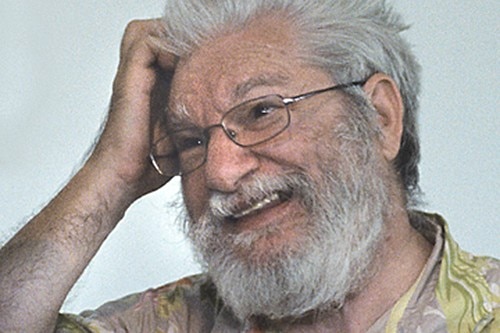This article was originally published on Domus 873, September 2004.
Capturing reflections
Sentences collected while following Dan Graham around his installation.
… About 26 years ago, when I was living on a DAD grant in Berlin, I read an article in Artforum by Peter Eisenman on Terragni, so I took a trip. Nobody knew who Terragni was at the time. I got into the Asilo because nobody was really interested in it in those years. Last time I came, about eight years ago, they wouldn’t let us in anymore.
… A few years ago, I revisited Casa Rustici in Milan. But what intrigues me most about Terragni is his project for the Danteum – his project is all about light, reflection and glass. Mies’s Tugendhat house, too; it’s all about reflections.
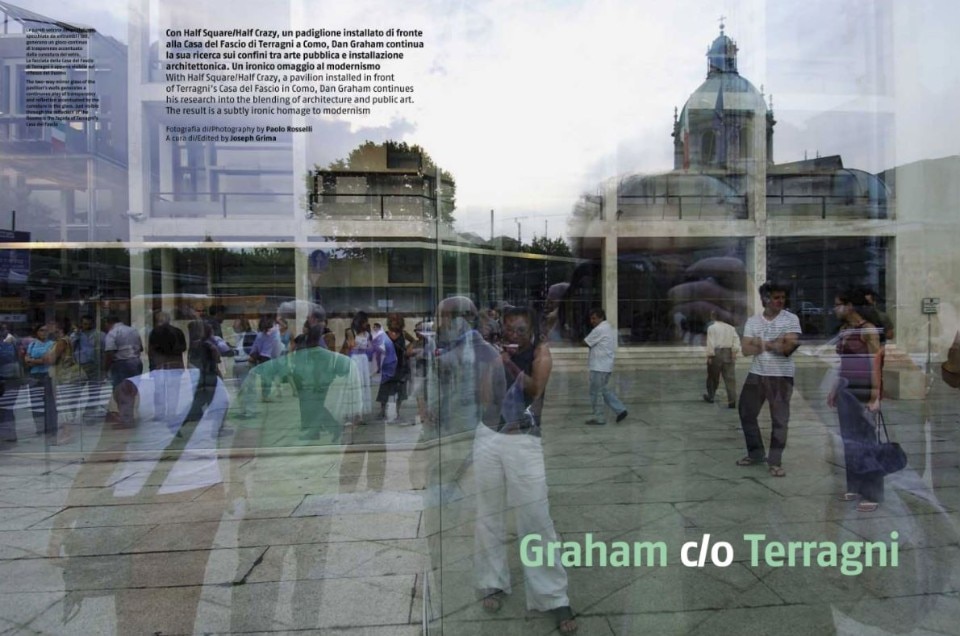
… What I don’t see in Terragni is landscaping. Mies did a lot of landscaping. The Danteum was a little bit like the Barcelona pavilion. It was an allegory. I’m interested in the use of allegory in the midst of rationalism, and also in the use of the curve. Mies van der Rohe uses curves in the Tugendhat house, and inside Casa del Fascio there are several circular elements. All my work in the last ten years involves curves, so I wanted to put some curves in a basically rectilinear situation. The curve is the 360° of the body, and if you extend it you get to the sky, so these curves relate partly to Como and partly to Casa del Fascio.
I’m interested in the pavilion form because it’s somewhere between architecture and art.
… I started by doing something for the outside near the church, but then Massimo Minini said they wanted to install the pavilion in the piazza, so I did a quick sketch and that’s it…
… Children love it because it’s like a hall of mirrors – they can see an enlarged reflection of themselves. Older women prefer the inside, which is convex…
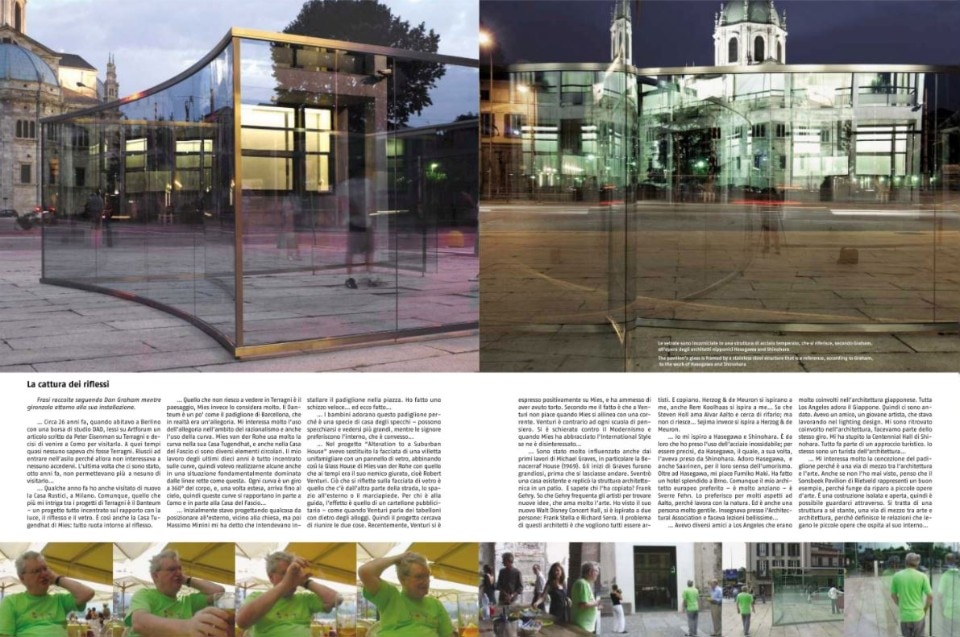
… In “Alteration to a Suburban House” I replaced the façade of a suburban bungalow with a glass panel. That project was an attempt to combine Mies van der Rohe’s Glass House with his enemy at the time who was Robert Venturi. What you actually see reflected in the glass façade is what’s across the street, the exterior space or the sidewalk. If you’re driving a car it’s like a billboard – it’s like when Venturi talks about the billboard with housing inside it. So the project was like putting the two together. Recently Venturi has said good things about Mies, he’s admitted he was wrong. I think the thing was he didn’t like corporate Mies. Venturi is very anti-corporate. He went against Modernism and when Mies went International Style he wasn’t interested…
… I was also very influenced by Michael Graves’ early work, in particular the Benacerraf House [1969]. Graves was great in the very beginning, before he fell apart. He cut away an existing house and replicated the architectural structure in a patio. You know who stole that? Frank Gehry. I know that Frank Gehry visits artists to get ideas, he loves art. I saw his new Walt Disney Concert Hall: he’s taking from two people, from Frank Stella and Richard Serra. The trouble with these architects is that they all want to be artists. And they copy. Herzog & de Meuron take from me, Rem Koolhaas takes from me… I know that Steven Holl loves Alvar Aalto. He tries to do Aalto, but he can’t really do it. Sejima takes from Herzog & de Meuron…
… I take from Hasegawa and Shinohara. That’s where I got the stainless steel, from Hasegawa, and he got it from Shinohara. I love Hasegawa, and also Saarinen, because of their humour. Along with Hasegawa, I like Fumiko Maki. But my favourite architect in Europe is quite old – it’s Sverre Fehn. In many ways he’s better than Aalto because he works with nature. And he’s also a very kind person. He taught at the Architectural Association – he used to do great lectures…
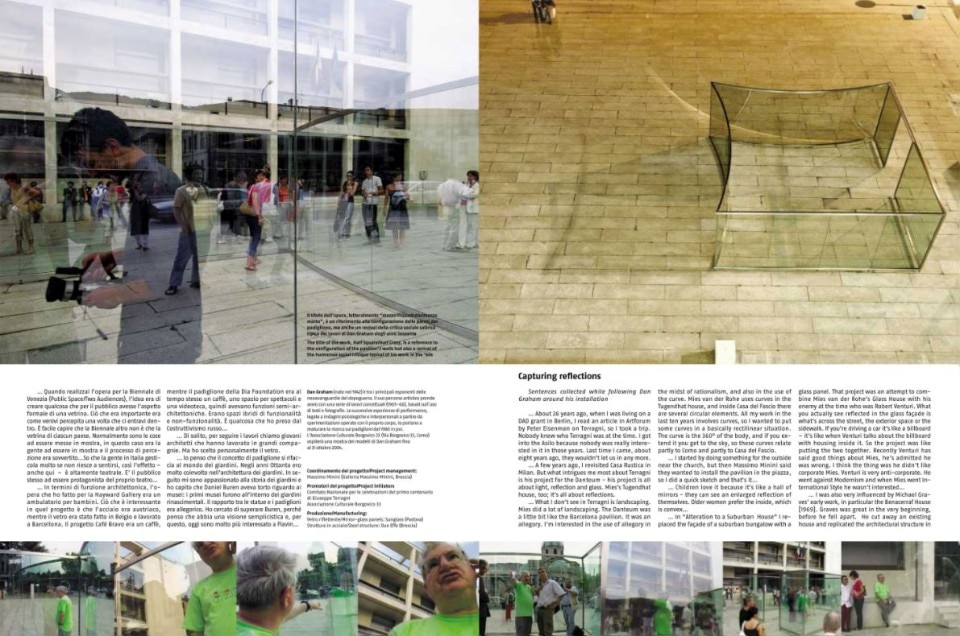
… I had several friends in LA who were very involved in Japanese architecture. LA worships Japan. So I went there – I had a friend, a young artist, who was working in lighting design and I got very involved in architecture so we were in the same circles. I was amazed by Shinohara’s Centennial Hall. It’s all part of tourism. I’m an architecture tourist.
… I’m interested in the pavilion form because it’s somewhere between architecture and art. I never saw it, but Rietveld’s Sonsbeek Pavilion is a good example because it’s a shelter for small works of art. It’s an open centre block, so you can see right through it. It’s a structure, just between art and architecture, because it defines the relationship between these small objects.
I’m interested in the use of allegory in the midst of rationalism, and also in the use of the curve.
When I did the Venice Biennale piece (Public Space/Two Audiences) the idea was to make a showcase window to give people a formalistic appearance. It was all about how you were perceived when you were in there. If you think about it, the Biennale itself is like a showcase for every country. Normally you put things on display; here people were on display – it was a subversion of perceptive processes… I knew that in Italy people gesticulate a lot if they can’t hear each other, so you get a lot of theatre. You’d be in the centre of your own theatre…
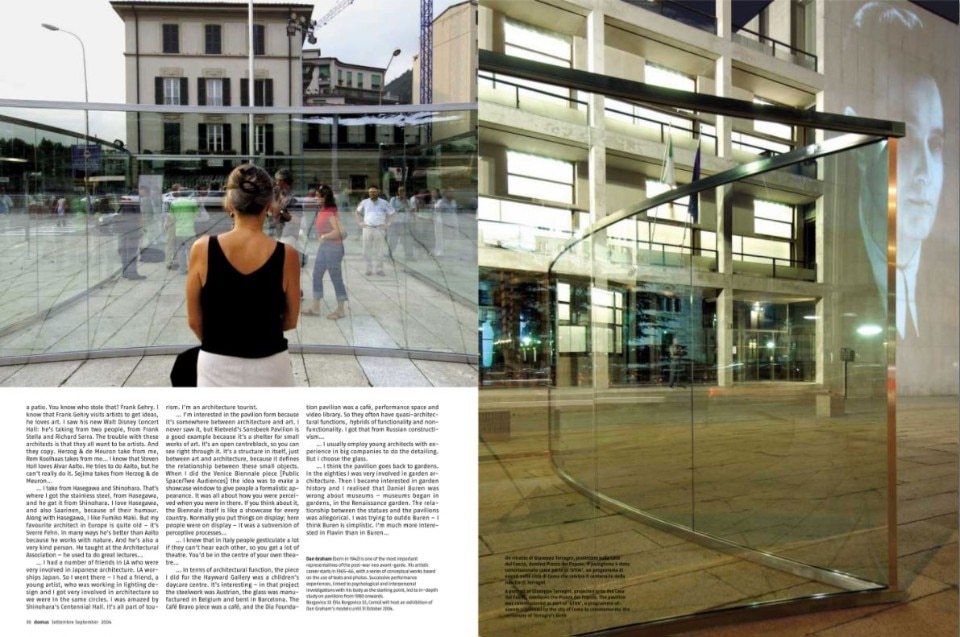
… In terms of architectural function, the piece I did for the Hayward Gallery was a children’s daycare center. It’s interesting – in that project the steelwork was Austrian, the glass was manufactured in Belgium and bent in Barcelona. The Café Bravo piece was a café, and the Dia Foundation pavilion was a café, performance space and video library. So they often have quasi-architectural functions, hybrids of functionality and non-functionality. I got that from Russian constructivism…
… I usually employ young architects with experience in big companies to do the detailing. But I choose the glass.
… I think the pavilion goes back to gardens. In the eighties I was very involved in garden architecture. Then I became interested in garden history and I realised that Daniel Buren was wrong about museums – museums began in gardens, in the Renaissance garden. The relationship between the statues and the pavilions was allegorical. I was trying to outdo Buren – I think Buren is simplistic. I’m much more interested in Flavin than in Buren…
Dan Graham (1942 – 2022) was one of the most important representatives of the post-war neo avant-garde. His artistic career starts in 1965-66, with a series of conceptual works based on the use of texts and photos. Successive performance experiences, linked to psychological and interpersonal investigations with his body as the starting point, led to in-depth study on pavilions from 1980 onwards.
Opening imagine: Dan Graham. Courtesy Monica Boirar


